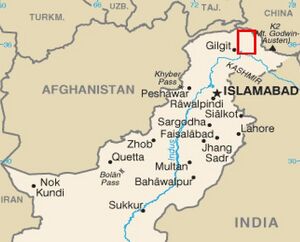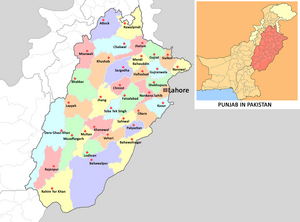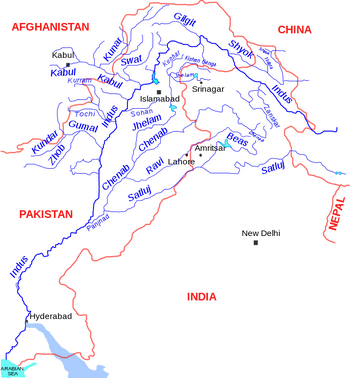Pothohar
| Author:Laxman Burdak, IFS (R) |


Pothohar (Hindi:पोथोहार, Punjabi: پوٹھوار, Urdu: سطح مرتفع پوٹھوہار ) is a plateau in north-eastern Pakistan, forming the northern part of Punjab (Pakistan). The major cities of Islamabad and Rawalpindi, and the smaller cities of Chakwal, Jhelum and Attock are situated on the plateau. Atri Jats had been Satrap of Pothohar.[1][2]
Location
It borders the western parts of Azad Kashmir and the southern part of Khyber Pakhtunkhwa.
Variants of name
Origin of name
Henry Walter Bellew[3] writes that Poti is the name of a district in Afghanistan (Tarnak valley), and of a district (Potwar) in the north of Punjab (Pakistan), so called perhaps from a Jat tribe of that name i.e Poti.
History

The region was once the home of the ancient Soanian culture, which is evidenced by the discovery of fossils, tools, coins, and remains of ancient archaeological sites. Existence of the Soanian culture finds its home on the plateau. The Indus Valley civilization is known to have flourished in the same region between the 23rd and 18th centuries BC. Some of the earliest Stone Age artifacts in the world have been found on the plateau, dating from 500,000 to 100,000 years. The crude stone recovered from the terraces of the Soan carry the account of human grind and endeavors in this part of the world from the inter-glacial period.
The Stone Age people produced their equipment in a sufficiently homogenous way to justify their grouping. Around 3000 BC, small village communities developed in the area, which led to the early roots of civilization.
Rawalpindi Gazetteer 1894 (see also Baburnama). This clan now live all over the region and famous villages are Samote, Sagri, Manyanda, Sakrana, Bishandoot, etc.
The ruins of the Shahi destroyed by Mahmud of Ghazni in the 11th century and of ancient Gandhara destroyed in the 6th century by the Hunas (Indo-Hephthalites) litter the countryside.
Ancient Taxila is an ancient UNESCO World Heritage Site located on the plateau. Taxila (then called taksh-shila) was Hindu and Buddhist seat of learning, connected across the Khunjerab pass to the Silk Road, attracting students from all over the world. Ancient Takshashila was renowned all over the world as home to a great university. It came under the control of the first Persian known then as the Achaemenid Empire followed by Alexander the Great and then the Sassanians. As a city in Gandhara it flourished during the first-fifth centuries AD. It was finally destroyed in c.450-c.565 by the Hunas.
The material remains found on the site of the city of Rawalpindi prove the existence of a Gandhara Buddhist establishment contemporary to Taxila but less celebrated than its neighbor. It appears that the ancient city also went into oblivion as a result of the same Hunas devastation. The Gakhar chief Jhanda Khan restored it and gave it the name of Rawalpindi after the village Rawal in 1493 AD. Today it is the twin city of the capital of Pakistan, Islamabad which was built next to it.
Rohtas Fort located in the Potwar is another UNESCO World Heritage site, built by Sher Shah Suri in 1541 to control the Gakhars who remained loyal to the deposed Mughal Emperor Humayun.[4][5]
Rawat Fort is located 17 kilometres east of Rawalpindi, on the Grand Trunk Road leading to Lahore. The grave of a Gakhar Chief, Sultan Sarang Khan is located inside the fort. He died in 1546 AD fighting against the forces of Sher Shah Suri. If one dares to climb the broken steps inside the tomb, one may get a panoramic view of the plateau and the Mankiala Stupa. The remains of this Buddhist Stupa lie about 32 km south east of Rawalpindi in Mankiala village. Apparently, this Gandhara stupa was built in the reign of Kanishka (128-151 AD). According to legend, Buddha had sacrificed parts of his body here, to feed seven hungry tiger-cubs. In 1930, several gold, silver and copper coins (660 - 730 AD) and a bronze casket having Kharoṣṭhī inscriptions, were discovered from this stupa.
Pharwala Fort is about 40 kilometres from Rawalpindi beyond Lehtrar road. The Gakhar ruler, Sultan Kai Gohar built it in 10th century on the ruins of a 10th-century Hindu Shahi Fort. Gakhars ruled Pothohar region for about eight hundred and fifty years. Emperor Babur attacked the fort in 1519 AD before Hathi (Hammad) Khan had acknowledged him.
The Salt Range is dotted with Hindu temples, of which the most notable is the Katasraj temple. Located 25 kilometres from Chakwal, Katasraj is notable in many ways. The temple was abandoned by local Hindu's when they migrated to East Punjab in 1947. Many legends sacred to the Hindu's are associated with it, some of them involving Shiva himself. It has always been the site of holy pilgrimage. Even nowadays, through an agreement between India and Pakistan, Hindu worshippers perform a pilgrimage to the temple every year and bathe in the sacred pool around which Katasraj is built. Legend says that the five Pandava brothers, heroes of the Sanskrit epic Mahābhārata, stayed here for four out of the 14 years that they spent in exile. While Katas Raj has not received much publicity, the two semi-ruined temples of the Hindu Shahi period (650-950 AD) have been frequently photographed by newspapers and history journals.
A joint project with Professors Abdur Rehman, past Chairman of the Department of Archaeology, University of Peshawar, and Farid Khan, founder of the Pakistan Heritage Society, has begun to analyse and document these important monuments in the history of South Asian temple architecture with funding from the University of Pennsylvania. Two seasons of excavation have been carried out at the site of North Kafirkot.[6]
Jat History
Bhim Singh Dahiya[7] writes about Atri - A seal inscription of Shiva Sena is noted which Cunningham read as, "Shivasena, of the race of Atri, Satrap of Pothowar".[8] Here Atri or Attri is a Jat of that clan.
Henry Walter Bellew[9] writes that Poti is the name of a district in Afghanistan (Tarnak valley), and of a district (Potwar) in the north of Punjab (Pakistan), so called perhaps from a Jat tribe of that name i.e Poti.
इतिहास
दलीप सिंह अहलावत[10] लिखते हैं: चन्द्रवंश में अत्रि नामक जो वंश प्रचलित है उसके मूलाधार ब्रह्मा जी के पुत्र अत्रि ऋषि माने जाते हैं। अत्रि जाट गोत्र, ब्राह्मणों के अत्रि गोत्र से अलग है क्योंकि महाभारत भीष्म पर्व 10वां अध्याय श्लोक 67 में अत्रि वंश को शूद्र लिखा है। ब्राह्मण अपने गोत्र को शूद्र नहीं कह सकते[11]। एक शिलालेख मिला है जिसके लेख को पढकर कनिंघम ने लिखा है कि “अत्रि वंश (कुल) का शिवसेन था, जो पोथोहार का मण्डलेश्वर (Satrap of Pothohar) था[12]।” यह अत्रि जाट गोत्र है। अत्रि वंश, शतपथ ब्राह्मण, मार्कण्डेय पुराण और महाभारत में भी इसको जाति (संघ) लिखा है। महाभारत में लिखा है कि अत्रि गोत्र का राजा इन्द्रदमन ब्राह्मणों को अनेक प्रकार के दान देता था[13]। मध्यकाल में अलीगढ़ जिले के खडे़हा गांव से यह अत्रि जाटवंश लोकप्रसिद्ध हुआ। इसी गांव से चलकर इस वंश के लोग अलीगढ जिले की खैर और टप्पल तहसीलों में जाकर बस गये, जहां पर इनके 60 गांव हैं। इनमें घरबरा और हरजीगढ़ गांवों के जाट अति उन्नतिशील हैं। ये लोग खड़ेहा गांव से आकर इन गांवों में बसे, इसी कारण इनको खड़िया अत्रि कहते हैं।
The People
Potohar is home to many different clans including QAZI, Khatris, Abbasi, Awans, Jatts, Dhamials, Bhattis, Hanjras , Janjuas, Thathals, Sattis, Mangral, Tarkhans,Gujjars, Gakhar clans and many others.
The Pothohar region is home to many tribes with multiple identities. For example, Dhamial, Langrial, Chhina and Bangial would in some instances call themselves Rajputs, and other instances call themselves Jats. In Jhelum District, Jat identity was fairly strong, and these tribes tend to consider themselves Jats.
Bhukar - A Jat clan found in Jhelum and Multan districts. They are one of the major Jat clans of the Pothohar region.
Dhamial are of both Rajput and Jat status, as are many tribes of the Pothohar region[14].They account for themselves as having come originally from Ghazni to the Sialkot District, from whence they went to Dhamiak (Jhelum Tehsil) where they built a fort. According to some other sources, both the Dhamial Jats and Rajputs are of Janjua descent. [15]
Awans originated in the Potohar region.
Henry Walter Bellew[16] writes that Poti is the name of a district in Afghanistan (Tarnak valley), and of a district (Potwar) in the north of Panjab, so called perhaps from a Jat tribe of that name.
Geography

Potohar Plateau is bounded on the east by the Jhelum River, on the west by the Indus River, on the north by the Kala Chitta Range and the Margalla Hills, and on the south by the Salt Range.[17] The Kala Chitta Range thrusts eastward across the plateau towards Rawalpindi; the valleys of the Haro River and Soan River cross the plateau from the eastern foothills to the Indus. The land of Pothohar and in general the whole of the Indian subcontinent was attributed as "Golden Sparrow" by East India Company.[18] The ramparts of the Salt Range stretching from east to west in the south separate Potohar from the Punjab Plain. The Potwar Plateau includes the current four districts of Jhelum, Chakwal, Rawalpindi, Attock.[19] The terrain is undulating. The Kala Chitta Range rises to an average height of 450-900 metres and extends for about 72 kilometres. The Swaan River starts from nearby Murree and ends near Kalabagh in the Indus river. Sakesar (Khushab District) is the highest mountain of this region and Tilla Jogian (Jhelum District) is second highest.
Most of the hills and rivers are bordered by dissected ravine belts. The streams, due to constant rejuvenation, are deep set and of little use for irrigation. Agriculture is dependent largely on rainfall, which averages 380-500 mm annually; rainfall is greatest in the northwest and declines to arid conditions in the southwest. The chief crops are wheat, barley, sorghum, and legumes, onions, melons, and tobacco are grown in the more fertile areas near the River Indus.
The diverse wildlife includes urial, chinkara, chukar, hare, mongoose, wild boar, and yellow-throated marten. Due to low rain fall, extensive deforestation, coal mining, oil and gas exploration, the area is becoming devoid of vegetation. The under water areas of lakes (Uchali, Khabeki, Jhallar and Kallar Kahar) have been reduced to much smaller areas than in the past.
The major cities of Islamabad and Rawalpindi, and the smaller cities of Chakwal, Jhelum and Attock are situated on the plateau.
External links
References
- ↑ Jat History Dalip Singh Ahlawat/Chapter III, पृ.183
- ↑ J.F. Fleet, Journal of Royal Asiatic Society, 1941 P. 103.
- ↑ Henry Walter Bellew: An Inquiry Into the Ethnography of Afghanistan, p.119
- ↑ "Rohtas Fort". Travel Web
- ↑ "Rohtas Fort". UNESCO-World Heritage. Retrieved 2008-06-23.
- ↑ "Salt Range Temples, Pakistan". University of Pennsylvania-School of Arts & Sciences.
- ↑ Jats the Ancient Rulers (A clan study)/The Jats,p.39
- ↑ J.F. Fleet, Journal of Royal Asiatic Society, XXXVIII, 1914, P. 103.
- ↑ Henry Walter Bellew: An Inquiry Into the Ethnography of Afghanistan, p.119
- ↑ Jat History Dalip Singh Ahlawat/Chapter III, पृ.183
- ↑ Bhim Singh Dahiya: Jats the Ancient Rulers (A clan study)/The Jats,p.24
- ↑ J.F. Fleet, Journal of Royal Asiatic Society, 1941 P. 103.
- ↑ Jats the Ancient Rulers, P. 278, B.S. Dahiya; महाभारत भीष्मपर्व अध्याय 9 में अत्रिवंश का जनपद भारतवर्ष में था।
- ↑ Punjab Castes Denzil Ibbetson Sang-e-Meel Publication
- ↑ Tehreek-e-Janjua by Raja Muhammad Anwar Khan Janjua (Sahiwal Press 1982, v1)
- ↑ Henry Walter Bellew: An Inquiry Into the Ethnography of Afghanistan, p.119
- ↑ "Salt Range: A Hidden Treasure". Daily Times. Retrieved 2008-06-23.
- ↑ "Pothohar the golden sparrow". ITslum Inc. Retrieved 2014-07-27.
- ↑ Gohar Social Studies base 4 , By S.A. Siddiqi , PAGE 6 , Gohar publishers
Back to Jat Places in Pakistan

